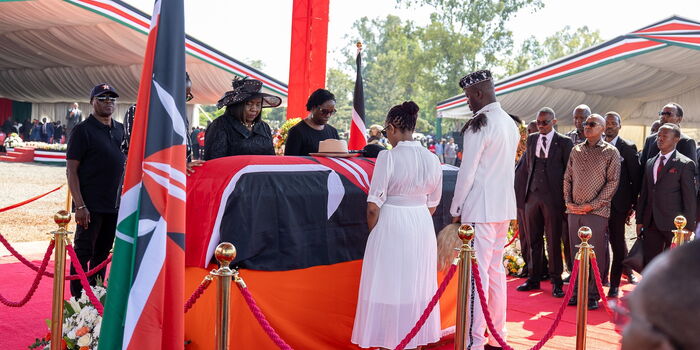Former Prime Minister Raila Odinga was laid to rest on Sunday evening at Kang’o Ka Jaramogi, his ancestral home in Bondo, Siaya County.
The burial was conducted in a deeply emotional and symbolic manner, attended by top national leaders, close family members and a limited number of mourners who were allowed into the final, more private session of the ceremony.
Raila, who passed away on Wednesday, October 15, in India, was buried wearing his iconic hat — popularly known as Ogudu in the Luo language — along with a ceremonial fly whisk, referred to locally as Orengo.
These two items were not just part of his personal identity but carried significant cultural meaning. According to Luo traditions, such symbols represent power, wisdom and leadership.
The ceremony became even more restricted when the time came to lower his casket into the grave. Only selected dignitaries, including President William Ruto, Cabinet Secretaries, senior ODM officials and close allies, were permitted to approach the graveside and lay flowers as a final act of honour.
Among those who stood beside the grave was Maurice Ogeta, Raila’s long-serving bodyguard. His presence was notable not only because of his long-term loyalty but also because President William Ruto gifted him a lifeline by promising him a government job — a gesture that warmed many hearts.
In Luo culture, being buried with a fly whisk carries deep spiritual significance. Traditionally, the whisk is a symbol of authority and respect, commonly associated with elders and influential community figures.
Placing it in the grave means the leader carries his honour and responsibilities into the afterlife, remaining a respected figure even in death.
Raila’s signature hat also had its own powerful meaning. Over the years, it became part of his public image — a symbol of his personality, resilience, lifestyle and political identity. Together, the hat and whisk served to honour not just the man he was, but everything he stood for — courage, leadership and dedication to the people.
Since the Luo believe that life goes on beyond death, burying someone with belongings they cherished ensures that they continue to enjoy dignity and comfort in the spiritual realm.
Another symbolic moment came when the military officially handed over the Kenyan flag to Mama Ida Odinga. This act represented national recognition of Raila’s lifelong service and sacrifice for the country.
Looking ahead, many people have already started speculating about his legacy and who might uphold it. Raila’s lastborn son, Raila Odinga Junior, has been widely mentioned as a possible successor. This speculation grew stronger after he was spotted holding the iconic fly whisk during the public viewing of his father’s body at Parliament Buildings — a gesture seen by many as a sign of inheritance, not just of a family heirloom, but of a political mantle.
The entire ceremony blended grief, honour and tradition — laying to rest not only a national leader, but a cultural icon whose influence will live on long after his burial.
Join Government Official WhatsApp Channel To Stay Updated On time
https://whatsapp.com/channel/0029VaWT5gSGufImU8R0DO30


